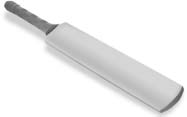
In all probability the Mary-le-Bone club was the White Conduit Club rechristened
Any cricket fan worth his salt will recognise this next object – the scarlet-and-gold tie of the Marylebone Cricket Club. The tie’s colours are colloquially called ‘eggs and bacon’, and it was at the tea gardens at White Conduit House in Islington that the club had its origins.
When Lord Martin Bladen Hawke, one of the great players of cricket’s ‘Golden Age’, wrote an essay about the origins of the MCC in 1937, he traced the club’s roots to the tea gardens in 1780. ‘By 1782 they had become known as the White Conduit Cricket Club,’ explained Lord Hawke. ‘From this aristocratic, if haphazard, beginning 150 years ago sprang the Marylebone Cricket Club.’ Beyond this, though, His Lordship wasn’t able to provide much in the way of specifics as to how and when exactly the MCC was born, nor have subsequent historians. What is known is that the White Conduit Cricket Club inaugurated their new ground at Lord’s (see chapter 28) with a match between the Mary-le-Bone club and the Islington Club on 30 July 1787. In all probability the Mary-le-Bone club was the White Conduit Club rechristened, a nod to the location of their new ground.
What was certain, however, was that the MCC soon became cricket’s sole arbitrator. Just a year after its formation, the club was asked to resolve a dispute between Leicester and Coventry concerning a batsman who in defending his wicket had struck the ball twice with his bat. The teams appealed to the MCC, ‘the first reputed cricket society in the Kingdom’.
This authority went unchallenged for nearly 100 years until 1867 – the year after the MCC had purchased the freehold of Lord’s Ground – when a letter was published in the Sporting Life proposing the establishment of a Cricket Parliament to replace the MCC as the game’s supreme court. The plan was motivated by a feeling of southern bias; that the MCC was a London club and was unrepresentative of English cricket now that the game had spread north to Lancashire and Yorkshire. The proposition called for a parliament of cricket legislators to be elected each year from across the country, but the demagogue’s cry fell on deaf ears.
One hundred and fifty years later the MCC remains arguably the most prestigious sports club in the world, but its influence on cricket has waned. In 1993 it ceded most of its power to the ICC, what Wisden described as a ‘notably unwelcome passage in their history’. In future the MCC would be like a twelfth man – people were aware of his presence but he could do little to influence the outcome of the match.

In all probability the Mary-le-Bone club was the White Conduit Club rechristened
That was followed five years later by a bitter row over the question of admitting women members. For 211 years the MCC had resisted, and when it went to a vote in February 1998 members once more voted to keep the status quo. They were universally ridiculed as a result, the New Zealand Sunday News labelling the club’s members ‘dinosaurs of world cricket’. The British government suggested the 18,000 members of the MCC might like to vote again. When they did in September 1998 the MCC succumbed to pressure and voted in favour of admitting female members. More recently, in 2012, the club turned on itself in a dispute over a proposed £400 million redevelopment of Lord’s, prompting John Major to resign from the main committee.
Increasingly, the MCC is to cricket what the Royal Family is to Britain – a benign figurehead, a symbol of another age and a bulwark against the brasher aspects of life. For many cricket fans the sight of an eggs-and-bacon tie is strangely reassuring, like an England batting collapse, restoring order to a chaotic world.
As for the origins of the MCC colours, they too are shrouded in mystery. According to the club’s historian, Glenys Williams, until the 1860s the club played in light blue. The red and gold made their first appearance in the 1860s, the same decade one of the club members, William Nicholson, advanced the money required to purchase the freehold of Lord’s Ground. Nicholson made his money from the family’s gin company, the colours of which were red and yellow. As Williams says: ‘Although no written proof has yet been found there is a strong family tradition that the adoption of the red and gold was MCC’s personal thank you to William Nicholson for his services to the club – sport’s first corporate sponsorship deal perhaps?’
Not a bad deal, and what are the chances that Nicholson also threw in a couple of cases of gin to keep the members content?